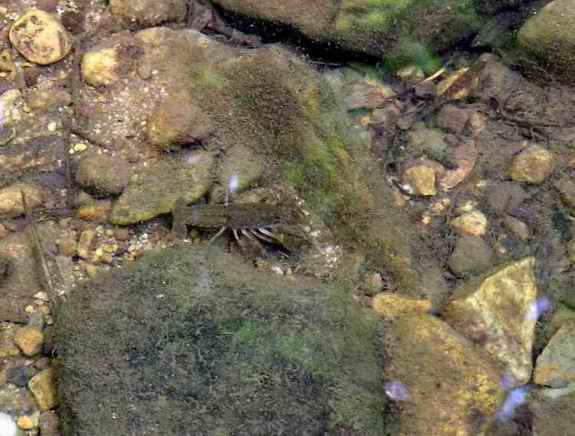|
Return to Hiker's Notebook Home Page
Common Names: Crayfish, Crawfish, Crawdad, Mudbug, Yabby - the primary name crayfish is derived by folk etymology from the Middle English crevis which in turn is of Germanic origin from the word krebiz, which means "edible crustacean." The original root word for both of the crustaceans is ceorfan, to cut, probably in reference to the predominant claws. Some references trace the name to �crevisse, the modern French word for crayfish; however, this also is derived from the German krebiz as the Old French crevise. "Cre - vis" became "cray - fish."
Scientific Name: Order Decapoda, Super family Astacoidea, Family Cambaridae - The Order is Latin for "ten feet" to indicate the number of pedal appendages known as pereiopods. Astacoidea is from the root word astakos which is Greek for crab. Cambaridae is from the root word kammaros, which is Greek for lobster.
The name of the "miniature lobster that one finds in lakes and streams" is subject to one of the more distinctive regional variances in nomenclature; it has accordingly been the subject of some surprisingly detailed study. Crawfish is the most popular (38.82%) and is pervasive in the South, followed by Crayfish in the Northeast (32.45%) and Crawdad in the Midwest (19.48%). One explanation is that the British colonial influence in New England engendered the British crayfish while the French colonial influence in the South engendered a somewhat different rendering from �crevisse that became manifest as crawfish vice crayfish. In the middle of the country which is more of a linguistic melting pot, it was Crawdad; it is quite obviously not a fish.
There is a great deal of diversity in crayfish; there are over 500 species in three families, two in the northern hemisphere and one in the southern hemisphere. Eastern North America and Australasia are the two areas that contain the most diverse populations. The family Cambaridae of eastern North America has over half of the known extant species in 9 different genera. The southern hemisphere Parastacidae family is indigenous to Australasia with over 100 species in 12 genera. The third family is Astacidae, native to Europe and western North America. Astacology is the study of freshwater crayfish; the International Association of Astacology was founded in Hinterthal, Austria in 1972. There are only 7 native species of crayfish in Europe and only one in Great Britain.
Crayfish are among the few decapods (lobsters, crabs and shrimp) that are adapted to fresh water. As they are the only major group of the order that spend their entire lives in fresh water, it is believed that they made this transition early in their evolution, suggestive of some significant physiological adaptations. The key difference between the ocean and inland waters is the salinity. Marine decapods have blood salinities that are in close equilibrium with the salt water environments. In making the transition to fresh water, freshwater decapods had to evolve a number of mechanisms to prevent the osmotic effects of the differing ionic concentrations from radically diluting their blood. These included a reduction in the permeability of the exoskeleton, a tolerance for blood concentration variance, and a means of excretion against a high concentration gradient.
Crayfish evolved a unique urinary tract physiology to deal with the salinity problem. A specialized canal takes the highly saline urine and removes the ions to the point that the urine is very dilute, the salinity retained by the body to maintain the chemical balance. A crayfish urinates 5 percent of its total body weight daily to maintain the necessary ion exchange ratio. The organ that performs the excretory function is known as the "green gland." The excretory pore is located just behind the mouth and does not extend to the end of the abdomen as is the case in the standard emunctory arrangement. The segmented abdominal tail is thus solely a means of propulsion with no intestinal function; it has five pairs of ventral appendages called swimmerets and a widened terminus called the telson.
Crayfish have the head, thorax and abdomen body segments that are characteristic of the arthropods. However, the head and thorax are combined into a single structure called a cephalothorax that is covered with a hardened exoskeleton called a carapace that provides a protective shield to the delicate gills and other internal body parts. Since the carapace does not expand once it is calcified, crayfish must periodically shed their skins, a process known as molting. Molting occurs approximately 6 to 10 times during the first year when growth is relatively rapid; the juvenile crayfish is particularly vulnerable to predation during this period. The expended carapace is ingested by the crayfish to reabsorb the calcium needed to form the replacement shield.
The crayfish is of considerable importance as an edible arthropod in Scandinavia, China, Australia and the United States; 98 percent of the North American crawfish come from Louisiana, where the euphonious, colloquial name "mudbug" is pervasive. A three ounce (85g) serving contains 15 per cent of the daily requirement for protein and iron with only 70 calories and one gram of total fat, none saturated. |
